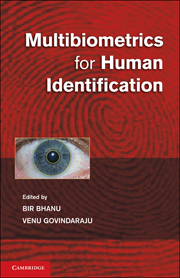Book contents
- Frontmatter
- Contents
- List of Contributors
- Preface
- Introduction
- PART I MULTIMODAL AND MULTISENSOR BIOMETRIC SYSTEMS
- PART II FUSION METHODS IN MULTIBIOMETRIC SYSTEMS
- 5 Biometric Authentication: A Copula-Based Approach
- 6 An Investigation into Feature-Level Fusion of Face and Fingerprint Biometrics
- 7 Adaptive Multibiometric Systems
- PART III HYBRID BIOMETRIC SYSTEMS
- PART IV DATABASES AND SECURITY
- PART V PERFORMANCE OF MULTIBIOMETRIC SYSTEMS
- Plate section
6 - An Investigation into Feature-Level Fusion of Face and Fingerprint Biometrics
from PART II - FUSION METHODS IN MULTIBIOMETRIC SYSTEMS
Published online by Cambridge University Press: 25 October 2011
- Frontmatter
- Contents
- List of Contributors
- Preface
- Introduction
- PART I MULTIMODAL AND MULTISENSOR BIOMETRIC SYSTEMS
- PART II FUSION METHODS IN MULTIBIOMETRIC SYSTEMS
- 5 Biometric Authentication: A Copula-Based Approach
- 6 An Investigation into Feature-Level Fusion of Face and Fingerprint Biometrics
- 7 Adaptive Multibiometric Systems
- PART III HYBRID BIOMETRIC SYSTEMS
- PART IV DATABASES AND SECURITY
- PART V PERFORMANCE OF MULTIBIOMETRIC SYSTEMS
- Plate section
Summary
Introduction
The term “biometrics” defines the analysis of unique physiological or behavioral characteristics to verify the claimed identity of an individual. Biometric identification has eventually assumed a much broader relevance as a new technological solution toward more intuitive computer interfaces (Hong et al. 1999; Jain et al. 1999).
Multibiometric systems Jain and Ross (2004) have been devised to overcome some of the limitations of unimodal biometric systems. In general terms, the combination of multiple biometric traits is operated by grouping multiple sources of information. These systems utilize more than one physiological or behavioral characteristic, or a combination of both, for enrollment and identification. For example, the problem of nonuniversality can be overcome, because multiple traits together always provide a sufficient population coverage. Multibiometrics also offers an efficient countermeasure to spoofing, because it would be difficult for an impostor to spoof multiple biometric traits of a genuine user simultaneously (Jain and Ross 2004). In some cases the sensor data can be corrupted or noisy, the use of multiple biometric traits always allow to reduce the effects of errors and noise in the data.
Ross and Jain (2003) presented a wide overview of multimodal biometrics describing different possible levels of fusion, within several scenarios, modes of operation, integration strategies, and design issues.
- Type
- Chapter
- Information
- Multibiometrics for Human Identification , pp. 120 - 142Publisher: Cambridge University PressPrint publication year: 2011
- 1
- Cited by



